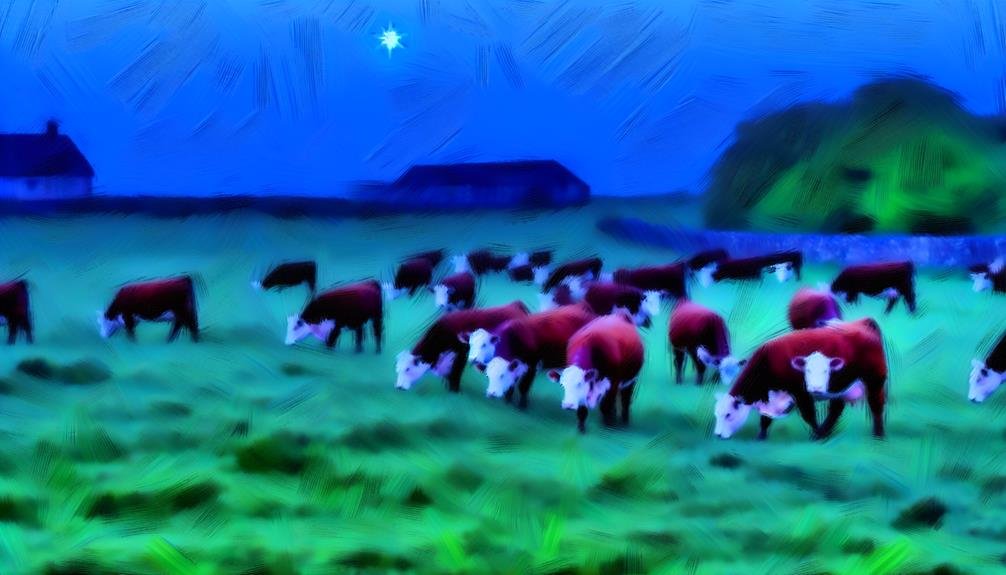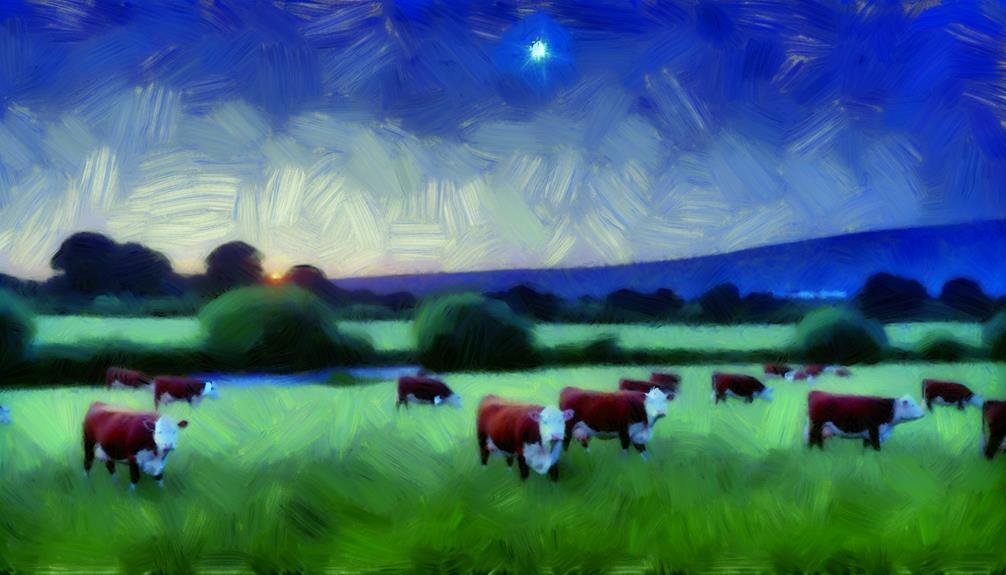Hereford cattle are known for their high-quality beef, exceptional feed efficiency, calm temperament, and adaptability to various climates. Their productive lifespan and disease resistance make them an economically sound choice for beef producers. However, they are prone to eye issues such as cancer eye and pinkeye, which require regular monitoring and preventive care. Additionally, their lower milk production makes them less suitable for dairy purposes, and they can struggle with heat stress due to their white facial markings. With proper management, Herefords can be highly rewarding, and understanding their detailed pros and cons can maximize profitability.
Takeaways
- Hereford cattle produce high-quality beef with excellent marbling and tenderness, ideal for premium markets.
- They have a calm temperament, making them easy to handle and manage.
- Herefords are highly adaptable to diverse climates, ensuring consistent beef supply.
- Susceptibility to eye issues like cancer eye and pinkeye requires regular monitoring and preventive care.
- Lower milk production makes them unsuitable for dairy-focused enterprises.
Advantages of Hereford Cattle
Hereford cattle offer numerous advantages, including the production of high-quality beef known for its exceptional tenderness and flavor. This breed is widely celebrated in the beef production industry for its superior meat quality, which is highly sought after by consumers.
One of the standout features of Hereford cattle is their efficient feed conversion. They excel in transforming feed into beef, making them a vital choice for producers aiming to maximize their returns on investment.
Moreover, Hereford cattle are renowned for their calm temperament. This characteristic not only simplifies handling and management on the farm but also reduces stress-related issues, which can negatively impact meat quality. Their docility makes them particularly suited for operations where ease of handling is essential.
Another significant advantage is their adaptability. Hereford cattle thrive in a variety of climates and environments, from temperate to harsher conditions, making them a versatile option for beef producers worldwide. This adaptability ensures that they can consistently perform and produce high-quality beef regardless of the geographical location.
Additionally, Hereford cows boast a long productive lifespan, contributing to sustained breeding and calf-rearing capabilities over many years, thereby enhancing the overall efficiency and profitability of beef production operations.
Disadvantages of Hereford Cattle

Despite their many advantages, Hereford cattle do face certain challenges that potential breeders should consider. These cattle are particularly susceptible to eye issues such as cancer eye and pinkeye, and their white facial markings can make them prone to sunburn.
Additionally, some lines may exhibit lower milk production and have difficulties with heat tolerance.
Susceptible to Eye Issues
One notable disadvantage of Hereford cattle is their susceptibility to eye issues such as cancer eye and pinkeye. These eye issues can have a considerable impact on the health and productivity of the cattle. Cancer eye, a malignant tumor affecting the eye, and pinkeye, an infectious disease causing inflammation and discomfort, are particularly prevalent among Hereford cattle due to their genetic predisposition and physical characteristics.
The white face and exposed eye areas of Hereford cattle make them more vulnerable to sun damage and subsequent infections. This susceptibility necessitates regular monitoring and preventive measures such as fly control and vaccination to manage these conditions effectively. Left unchecked, eye issues can lead to reduced vision, significant discomfort, and increased treatment costs for Hereford cattle owners.
Below is a table that highlights the key aspects of eye issues in Hereford cattle:
| Eye Issue | Impact on Hereford Cattle |
|---|---|
| Cancer Eye | Malignant tumors affecting the eye, leading to vision loss and discomfort |
| Pinkeye | Inflammation and irritation caused by bacterial infection, often exacerbated by flies |
| Sun Damage | Increased risk due to exposed eye areas, leading to higher susceptibility to infections |
Despite these challenges, proper management practices, including regular health checks and preventive care, can mitigate the impact of eye issues, ensuring the overall well-being of Hereford cattle.
Lower Milk Production
In addition to their susceptibility to eye issues, another drawback of Hereford cattle is their lower milk production compared to dairy-specific breeds. Hereford cows are primarily bred for beef production, which means that their genetic selection has not focused on maximizing milk yield. As a result, their milk production does not meet the standards typically required by the dairy industry.
While Hereford cows are generally adequate at nursing their calves, their milk output is notably lower than that of specialized dairy breeds such as Holsteins or Jerseys. Dairy farmers who prioritize high milk yield generally opt for these specialized breeds to guarantee a more consistent and abundant milk supply.
The dairy industry demands high-efficiency milk production, and Hereford cattle, despite their numerous advantages in beef production, fall short in this regard. This makes them less suitable for operations where milk production is a primary concern.
Hence, when considering Hereford cows, it is important to recognize that they are not an ideal choice for dairy-focused enterprises.
Heat Tolerance Concerns
Hereford cattle face significant challenges in extreme heat due to their dark red color and white markings, which make them more susceptible to sunburn. Their white faces and udders are particularly prone to sunburn, necessitating additional care in hot climates. Heat tolerance is a vital concern for Hereford cattle, as heat stress can adversely affect their overall health and productivity, presenting significant challenges in certain environments.
To mitigate these issues, breeders in warm regions must adopt effective management practices. Providing adequate shade, ensuring consistent access to water, and implementing cooling systems are essential measures to help Hereford cattle cope with high temperatures. Despite these heat tolerance concerns, Hereford cattle exhibit commendable climate adaptability, with proper management practices playing a pivotal role in maintaining their well-being.
Here's a summary of the considerations for managing Hereford cattle in warm regions:
| Aspect | Concern | Solution |
|---|---|---|
| Sunburn Susceptibility | High | Provide shade |
| Heat Tolerance | Challenging | Ensure constant water supply |
| Climate Adaptability | Notable but limited in heat | Implement cooling systems |
| Management Practices | Essential | Adopt proactive measures |
| Warm Regions | High-risk | Increase monitoring and care |
Adaptability and Climate Tolerance

Renowned for their exceptional adaptability, these cattle thrive in a wide range of climates, from tropical to temperate zones. Hereford cattle exhibit remarkable climate tolerance, enabling them to flourish in diverse climates and geographical regions. This robust adaptability is evident in their capacity to withstand a variety of weather conditions, including both extreme heat and cold. Their resilience to harsh environmental factors makes Hereford cattle a versatile breed, suitable for farmers and ranchers across the globe.
Over time, Herefords have proven their ability to endure and perform well in challenging climates, showcasing their adaptability. This characteristic has greatly contributed to their global popularity and widespread distribution. Their robust constitution allows them to maintain productivity and health in varying weather conditions, which is a reflection of their enduring adaptability.
Moreover, Hereford cattle's ability to efficiently convert pasture into beef underscores their suitability for different feeding and environmental conditions. This efficiency further reinforces their reputation as a versatile breed capable of thriving in diverse climates. Consequently, the adaptability and climate tolerance of Hereford cattle make them an invaluable asset to livestock producers in many regions.
Feed Efficiency and Meat Quality

Frequently praised for their feed efficiency, Hereford cattle excel in converting grass into body mass, making them an ideal choice for sustainable beef production. This breed's ability to efficiently utilize forage resources not only minimizes feed costs but also supports environmentally friendly farming practices. Hereford cattle are recognized as 'easy keepers,' requiring fewer inputs to achieve desirable meat production weights, thereby enhancing their economic viability for producers.
The meat quality of Hereford cattle is another significant advantage. Renowned for producing high-quality beef with exceptional marbling and tenderness, Hereford beef meets the exacting standards of consumers and chefs alike. This superior beef quality translates into enhanced flavor, making Hereford beef a preferred choice for premium markets and high-end restaurants.
Furthermore, Hereford cattle's ability to thrive in a range of climates adds to their appeal. Their adaptability and resilience in diverse environmental conditions ensure a consistent and reliable beef supply, regardless of location. This adaptability, combined with their renowned feed efficiency and meat quality, positions Hereford cattle as a top contender in the beef industry.
Temperament and Handling

Beyond their feed efficiency and meat quality, the gentle temperament of Hereford cattle greatly enhances their manageability on the farm. Known for their calm disposition, Herefords are easy to handle, making them a preferred choice for both novice farmers and seasoned ranchers seeking low-stress livestock. Their docile nature and manageable temperament considerably reduce the risks associated with handling and managing large animals.
The ease of working with Hereford cattle translates into practical benefits for everyday farm operations. Tasks such as checking, sorting, and managing the herd can be performed with minimal assistance, thereby improving efficiency. Additionally, Herefords are generally respectful of fences, reducing the likelihood of escape and the consequent need for repairs or retrieval.
Here is a summary of key attributes related to Hereford cattle temperament and handling:
| Attribute | Description |
|---|---|
| Gentle Temperament | Enhances manageability and handling ease |
| Easy to Handle | Suitable for beginners and experienced farmers alike |
| Low-Stress Livestock | Reduces risks and promotes a calmer working environment |
| Manageable Temperament | Facilitates daily farm tasks with minimal assistance |
| Respectful of Fences | Decreases chances of escape and potential accidents |
Health and Longevity

Hereford cattle are renowned for their robust health and impressive longevity, often translating into extended productive years within a herd. Their inherent disease resistance traits, coupled with strong maternal instincts, contribute greatly to their lifespan and productivity.
Proper veterinary care and selective breeding further enhance these attributes, ensuring Hereford cattle remain a resilient and valuable asset to livestock operations.
Disease Resistance Traits
Exhibiting remarkable disease resistance, Hereford cattle are known for their overall health and longevity. Their disease resistance traits greatly contribute to their hardiness and robust constitution, allowing them to thrive in a variety of environments. This resilience greatly reduces their susceptibility to common cattle diseases, making them a preferred choice for many cattle producers.
The Hereford breed's robust constitution and strong immune system are central to its ability to prevent and combat illnesses. These cattle require minimal veterinary interventions, which is a confirmation of their natural disease resistance. This aspect not only guarantees better health outcomes but also translates to economic benefits for farmers, as reduced medical needs imply lower maintenance costs.
Selective breeding and a solid genetic foundation have played pivotal roles in enhancing the disease resistance traits of Hereford cattle. This meticulous breeding process has resulted in a breed that is highly resilient to a multitude of cattle diseases. Consequently, Herefords have established a reputation for their enduring health and longevity, making them an invaluable asset in the livestock industry.
Lifespan and Productivity
The impressive lifespan and sustained productivity of Hereford cattle underscore their value in the beef production industry. Herefords are renowned for their remarkable longevity, often maintaining productivity for 10-15 years. This extended productive lifespan greatly enhances economic returns for producers by reducing the frequency of herd replacement.
A key factor contributing to the productivity of Hereford cattle is their strong maternal traits. These traits guarantee high calf survival rates, thereby boosting overall herd productivity. The breed's adaptability and hardiness also play vital roles in their sustained productivity. Herefords can thrive in diverse environmental conditions, from harsh winters to hot summers, making them suitable for various geographic regions and farming practices.
In addition to their adaptability, Herefords are known for their efficient conversion of feed to beef. This efficient feed conversion ratio allows producers to achieve higher weight gains in shorter periods, further enhancing the breed's economic value. The combination of longevity, strong maternal traits, adaptability, and efficient conversion makes Hereford cattle a highly productive and economically viable choice for beef producers.
This multifaceted productivity underscores the importance of Herefords in the global beef production industry.
Veterinary Care Requirements
Guaranteeing the health and longevity of Hereford cattle requires a thorough approach to veterinary care that includes regular check-ups and preventive measures. Hereford cattle are known for their robust health and can often live up to 15 years or more. However, maintaining such longevity necessitates diligent veterinary care to address and mitigate potential health issues.
Common health issues in Hereford cattle include pinkeye, cancer eye, and udder problems. These conditions demand prompt veterinary attention to prevent complications that could affect the overall well-being and productivity of the herd. Regular check-ups are essential for early detection and management of these ailments, ensuring that any health concerns are addressed promptly.
Preventive healthcare is a cornerstone of effective veterinary care for Hereford cattle. This includes proper nutrition, routine vaccinations, and thorough parasite control measures. Implementing these preventive strategies can greatly reduce the incidence of disease and enhance the overall health status of the herd.
Investing in regular veterinary care and preventive healthcare measures not only supports the health and longevity of Hereford cattle but also ensures their productivity and economic value in the long term. Effective veterinary care is thus essential for maintaining a thriving and sustainable herd.
Frequently Asked Questions
What Are the Negative Traits of Hereford Cattle?
Hereford cattle exhibit negative traits such as genetic disorders, hoof health issues, heat sensitivity, and low fertility. Additionally, temperament issues and susceptibility to conditions like cancer eye and pinkeye necessitate proactive management and careful breeding practices.
What Are the Advantages of Hereford Cattle?
The advantages of Hereford cattle include their climate adaptability, feed efficiency, and temperament stability. Additionally, they offer excellent meat quality and exhibit notable disease resistance, making them a valuable asset for beef producers.
Are Herefords Better Than Angus?
The determination of whether Herefords are better than Angus hinges upon breed comparison, market demand, climate adaptability, feeding efficiency, and genetic diversity. Each breed's strengths align differently with the producer's specific operational goals.
Are Hereford Cattle Good or Bad?
Hereford cattle are generally considered good due to their favorable breeding considerations, adaptability to various grazing preferences, and contribution to genetic diversity. However, veterinary concerns and market demand trends must be factored into their overall assessment.
Conclusion
To conclude, Hereford cattle offer numerous advantages such as adaptability, feed efficiency, and favorable meat quality.
However, these benefits are counterbalanced by certain disadvantages, including susceptibility to specific health issues and potential challenges with temperament.
The breed's ability to thrive in diverse climates and its longevity further underline its value in livestock farming.
Weighing the pros and cons is essential for making informed decisions regarding the integration of Hereford cattle into agricultural operations.

